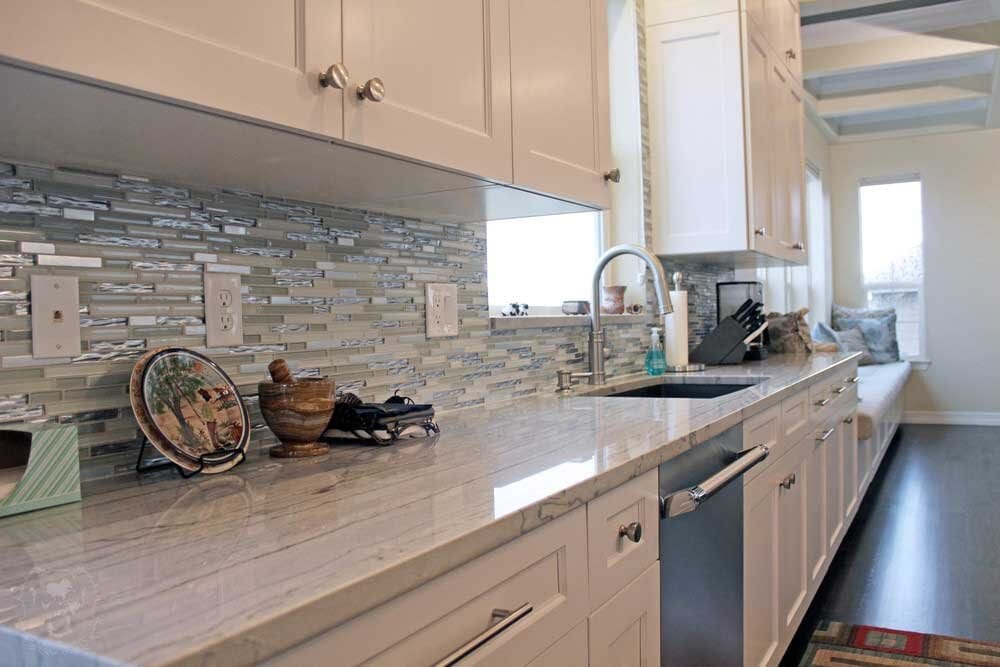Granite is one of the most elegant choice for a kitchen countertop. It is very easy to clean and will make you proud of your kitchen. Granite countertops add a touch of elegance to any space. This natural material is exceptionally durable, and fits any décor style. The challenge in selecting the right material is that there are so many styles, patterns, and colors that it can be difficult to choose. There are several factors to consider when selecting the right granite countertop. Here are a few reason you’ll want to consider granite for your next project.
kitchen countertops
Your Guide to 6 Kitchen Island Styles
By Sam Ferris
There are plenty of reasons to include an island in your kitchen — extra storage, seating and workspace, for example. But there are also several reasons why you might want to choose one island shape and style over another. This guide to six popular kitchen island styles will help you determine which one is right for you.

1. L-Shaped
This type of island can ebb and flow with the shape of your kitchen or fill in the blank space with more storage and prep space.
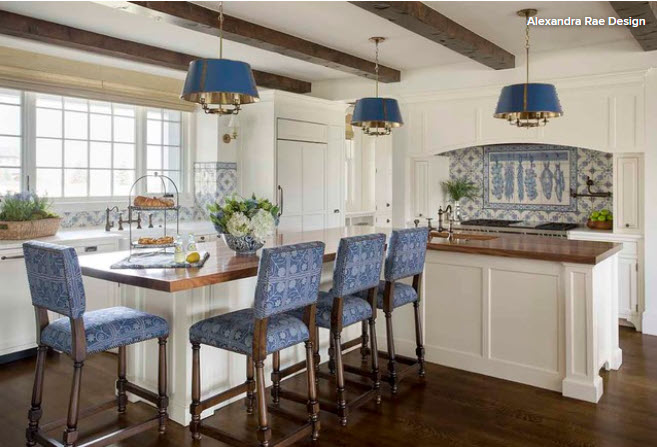
Pros. L-shaped islands tend to be large with correspondingly generous storage. Their sprawling design ensures that workspace isn’t crowded, a huge perk for households with avid chefs or more than one cook. You won’t have an issue finding room for bar-style seating. If you aren’t a fan of clean lines, L-shaped islands bring some intrigue to the table.
Cons. While L-shaped islands may be larger and provide more prep space, they aren’t exactly open-concept. They can chop up your kitchen design, which can hamper efficiency during meal prep. The shape may be too spread out for some homeowners, and it doesn’t always maximize storage space since corners tend to decrease accessibility.
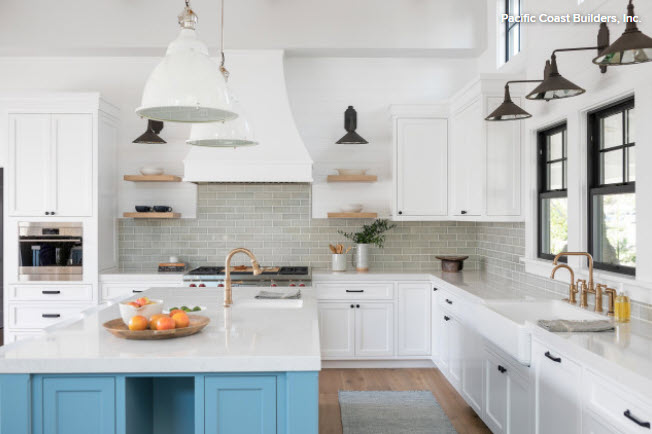
2. Galley
With fewer frills and a straightforward design, galley islands are built to be workhorses. They can be a good fit for any type of kitchen layout, assuming that there’s enough space for one.
Pros. Often considered the quintessential island design for open-concept kitchens, galley islands ensure that your space has flow and remains efficient with their streamlined design. They usually maximize storage space because there aren’t any corners or curves. Appliances and stored items are always accessible. The design also favors bar-style seating.
Cons. Yes, galley islands are simple and efficient, but some homeowners may think they’re boring. They certainly won’t wow the eye unless they’re larger than life or have an intricate exterior. Sometimes they’re too small to comfortably fit an appliance, which can create problems with your layout.
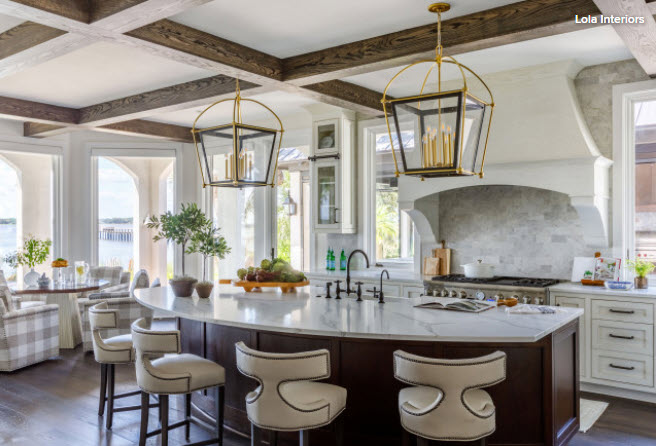
3. Circular or Curved
If you’re looking to add personality to your kitchen layout, a circular island may be for you. The design can go full circle or feature a half-moon.
Pros. Circular and curved islands add an interesting visual dynamic to kitchens. They’re a go-to option if you don’t want a run-of-the-mill island design. Like L-shaped islands, they’re packed with prep space. There’s more than enough room to operate during meal prep. Circular designs can incorporate expansive seating areas that leave enough room for four-plus guests to comfortably eat and socialize.
Cons. Prep and storage space aren’t always efficient with circular islands. Your counter is spread out and curved, which can limit the way you cook. Storage units can be harder to access in some designs (they may be underneath a countertop overhang, for instance). Plan on wasted storage space unless your cabinets are customized to include creative options.
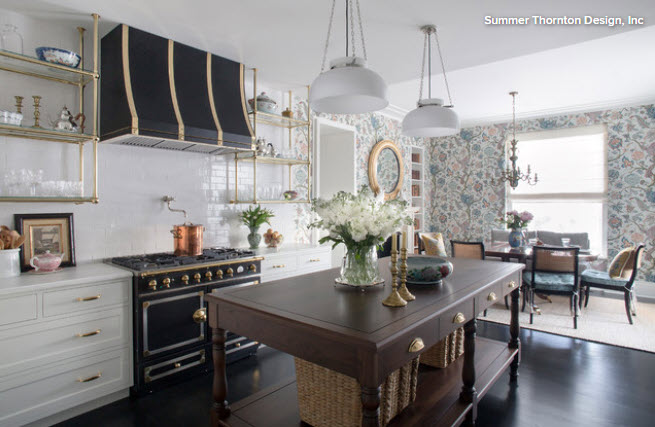
4. Furniture-Style
An unconventional choice, furniture islands can make your kitchen feel like your home’s premier hangout spot. Wide-ranging options can include a custom piece designed by a local carpenter and an antique table or chest of drawers.
Pros. It doesn’t matter if it’s custom-built, an age-old heirloom or store-bought — a furniture piece adds character to your kitchen. It’s one way to put your personal touch on your space and make it your own. The detail and decorative nature of the furniture will catch the eye of guests. These pieces usually aren’t bulky and fit seamlessly within your kitchen. Open-style designs can create fine displays for your decor.
Cons. Furniture pieces weren’t always built for storage, so that antique you had to have may not hold much of your cookware. There’s also the issue of durability. Older pieces may not last in the hustle and bustle of a modern kitchen. Wear and tear can take their toll. Furniture tops can’t take a beating the way granite or quartz can.
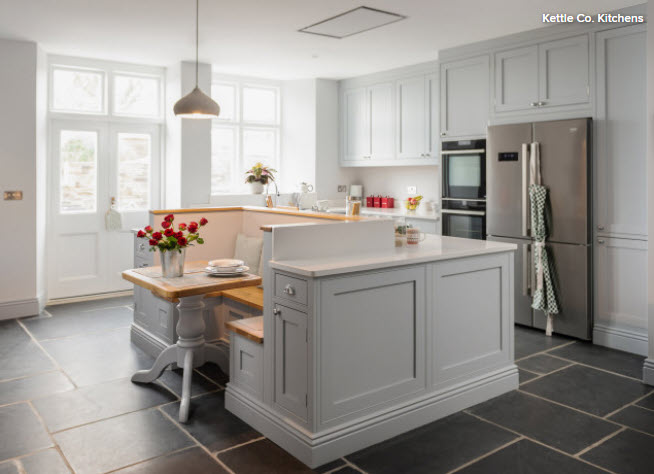
5. U-Shaped
U-shaped islands may be a chef’s dream. Three walls of cabinetry and appliances are enough to increase the efficiency of any kitchen.
Pros. Both highly functional and spacious, U-shaped islands are perhaps the largest and most accommodating. Extra storage space? Check. More workspace? You got it. Room for seating? There’s even that too. They can house more than one appliance if they’re big enough. You may not have to leave your island when you’re prepping food.
Cons. Their sheer size can also be the U-shaped islands’ biggest downfall. Some homeowners may find cooking and cleaning less efficient and may hate going the distance from one side to the other. These islands are bulky and can close off your kitchen from the rest of your home. The double corners will sacrifice accessible storage space unless they feature a Lazy Susan or swing-out device.
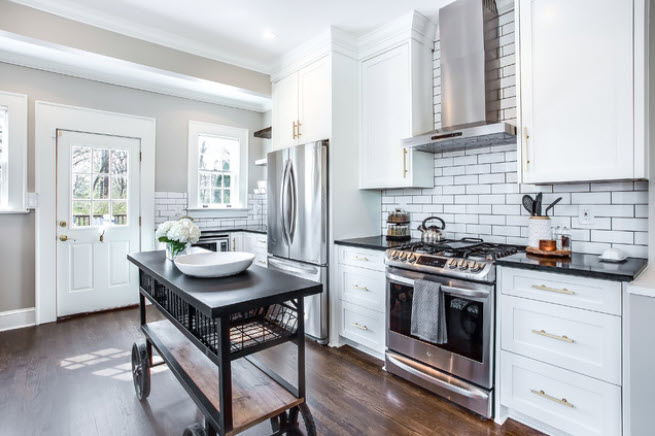
6. Rolling
No room for a built-in island? No problem. Rolling islands are a convenient alternative. You can whisk them around as you roam your kitchen and then tuck them neatly aside when you’re finished cooking.
Pros. Rolling islands are the crème de la crème in versatility. A godsend for smaller kitchens that lack adequate prep space, they can function as a worktop, food tray or a spare surface to place your ingredients. Depending on their size, they’re easy to stow and move. Best of all, they’re extremely affordable compared with cabinetry
Cons. Whipping up meals on wheels isn’t for everyone. Rolling islands are compact, which simply won’t work for some homeowners, even ones who are short on space. They can be a hassle to roll out during meals or to store. Bigger designs may be hard to move for some homeowners. They offer little to no storage.
How to Find Your Kitchen Style
If you’re planning to remodel your kitchen, here’s how to find inspiration and start narrowing down your choices.
When most homeowners embark on a kitchen remodel, they spend endless hours collecting inspiring kitchen photos. But this doesn’t necessarily help people figure out what they want, and it can even cause confusion. The tough part of the process is learning to narrow down the options and home in on what you want your dream kitchen to look like.
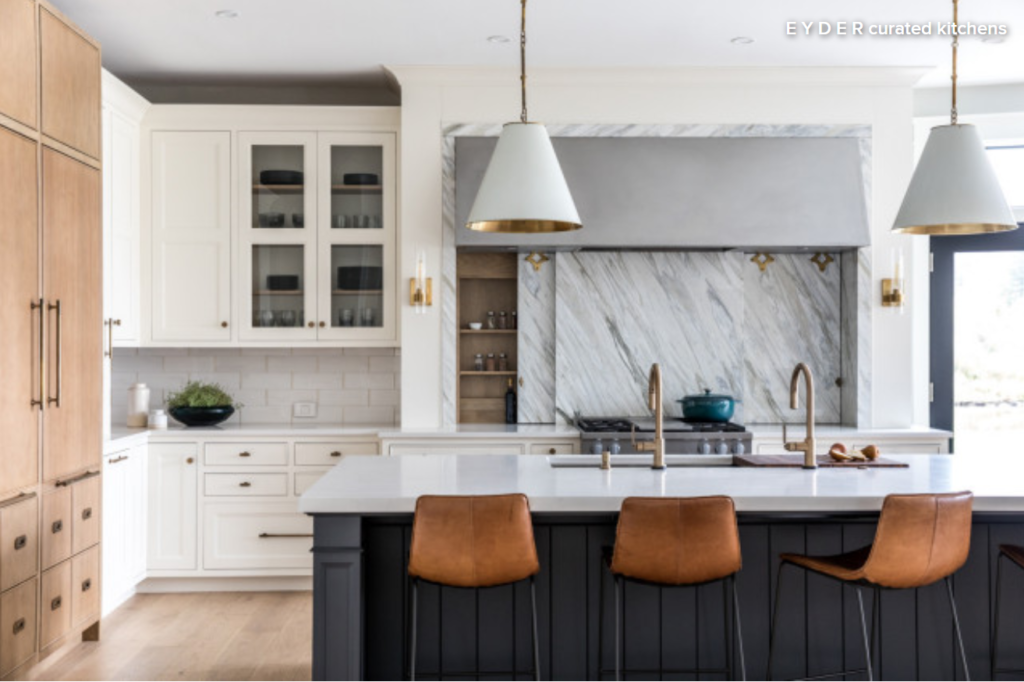
Gather Inspiration
Collect images. You may not be able to see it at first, but a pattern will show itself. You may find that a whole bunch of your kitchen inspiration images may need to be added to an ideabook for a future farmhouse or weekend getaway, but don’t skip over them just because they don’t relate to this project, save them for later.
Don’t edit yourself (yet). Don’t make yourself nuts from the get-go by trying to edit as you collect. I really believe in collecting with reckless abandon first and editing later. Editing yourself while you gather inspiration can be challenging and stifling for creativity.

Organize (but only if you want to). It’s OK to be unorganized and even a little messy with your photo categorization. If you’d like to organize your photos in your ideabook, then you’re a step ahead of us, but for those who don’t, don’t sweat it. There’s time to go back to your photos and label them later.
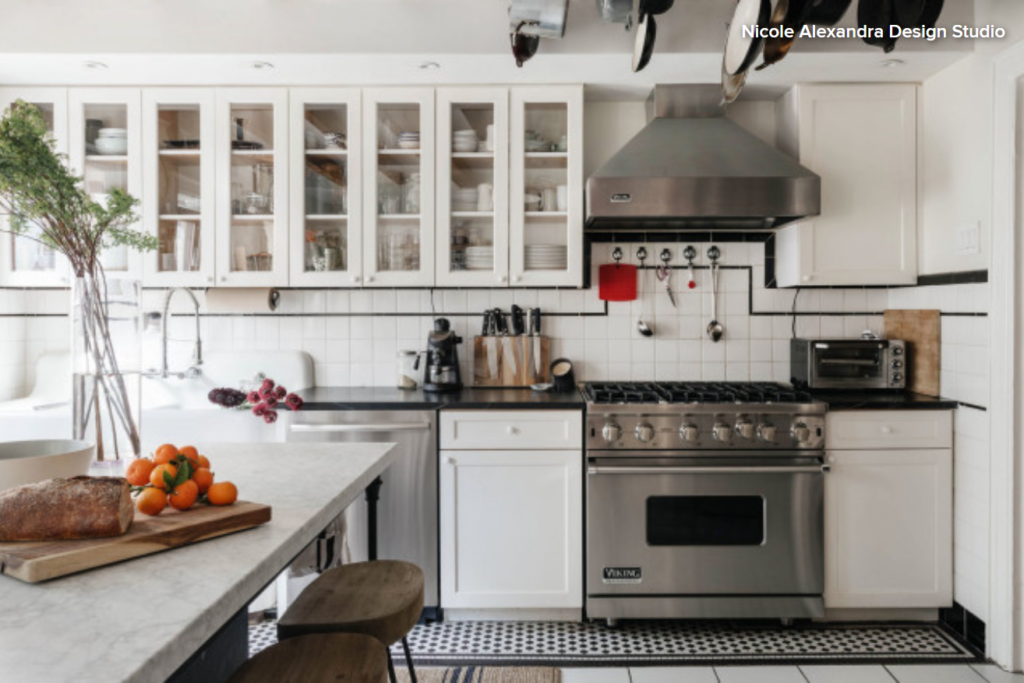
Start looking for a pro. This can be a great time to start noting the professionals who are responsible for the designs you like and looking for a design professional you might like to interview. For some homeowners, the right thing to do is hire a professional out of the gate and have him or her help you through this inspiration-gathering phase. Some homeowners even hand this off completely to a designer, and it’s the designer’s job to listen, interpret, and collect inspiration for the client and bring it back for approval.
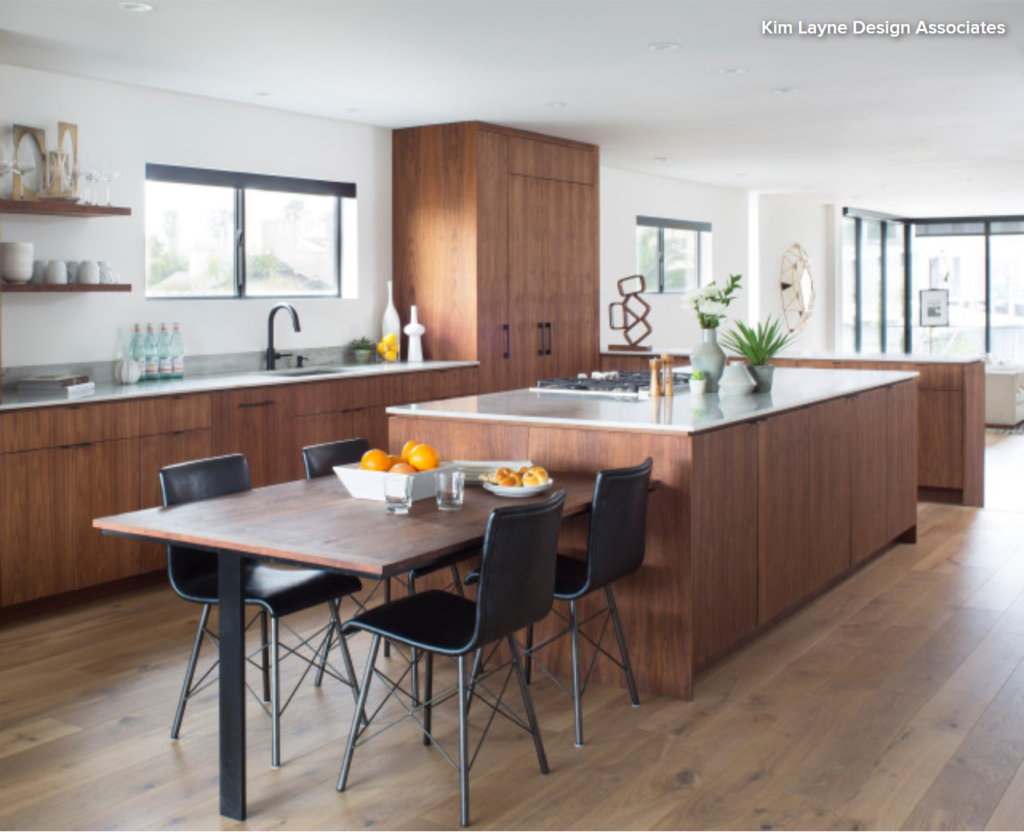
Categorize Photos
Once you have a fair number of inspiration images to work with, go back through them and put them into loose categories.
You can categorize by style: Maybe you seem to fall on the fence between vintage and modern. Or maybe you find that you have a bunch of images of kitchens with dark wood floors. You can create a collection dedicated completely to islands or kitchen banquette seating. Consider creating an idea book for lighting, one for wallpaper, and any other details you’d like to single out. For now don’t think about why you like things, just that you do or don’t.
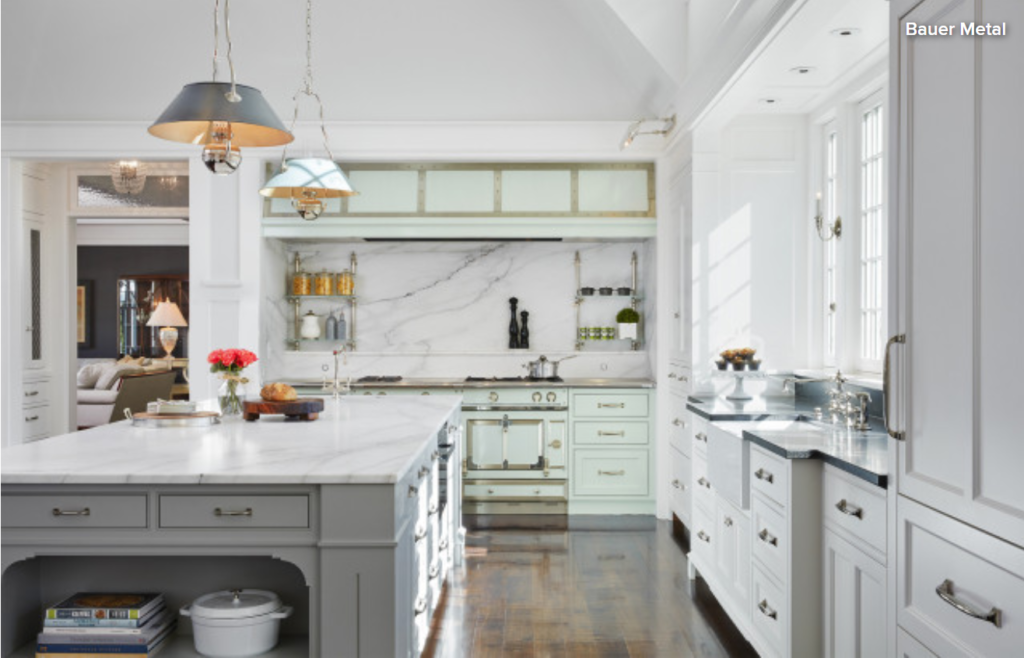
Edit Your Selections
Go back through your ideabooks and see if you still respond emotionally to the images within. If it’s been a while since you started gathering inspiration and you’ve looks at hundreds of spaces, your taste might have changed without you even realizing it. Ruthless editing can help clarify things. You’ll look at a room and say “Why on earth did I save that photo?” If you can’t remember and it doesn’t speak to you any longer, ditch it. See how easy that was?
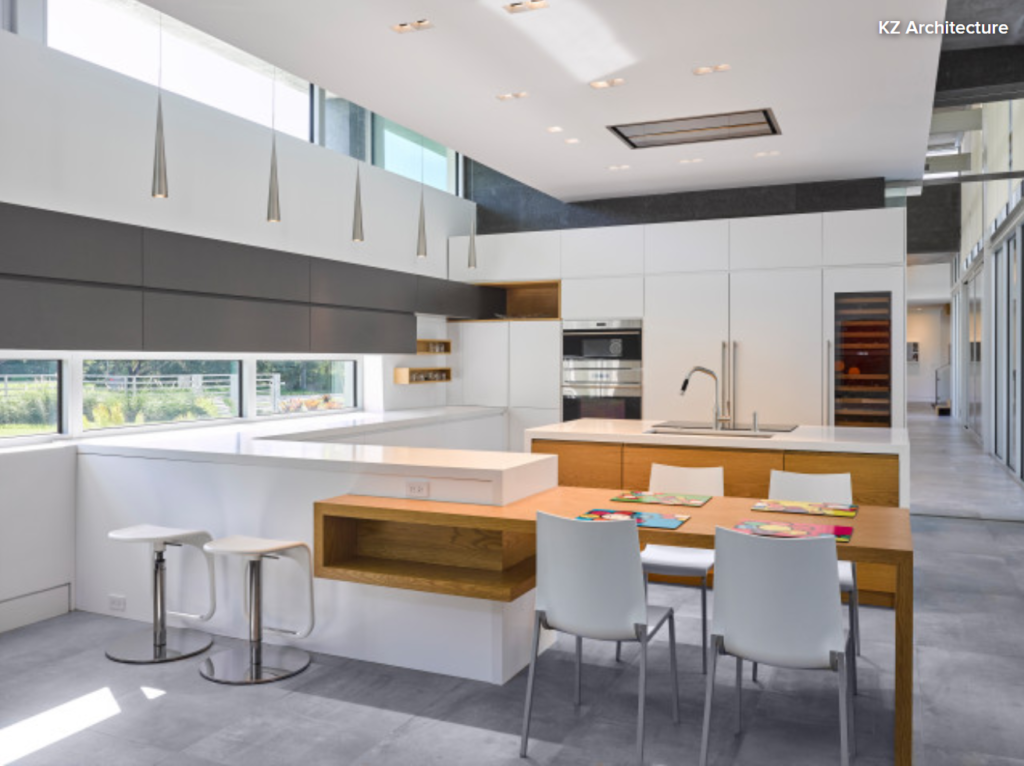
Collect Images With Intention
Now that you’ve collected at random, categorized and edited, go back through all your saved photos and review images for specific items. Look only for glass-front cabinets, industrial hoods or island lighting, for example, not at the image as a whole. You might not like all features of a room, but one element could be exactly what you want.
When working with a client — often more than once during a project — I pull inspiration images and say, “Don’t look at the wall color or the cabinet style. Just look at the hood.” Or “look at the way the crown molding transitions around the beam and hood” or something very specific like that. Make a note beneath a photo with an element you like and edit your photos again.
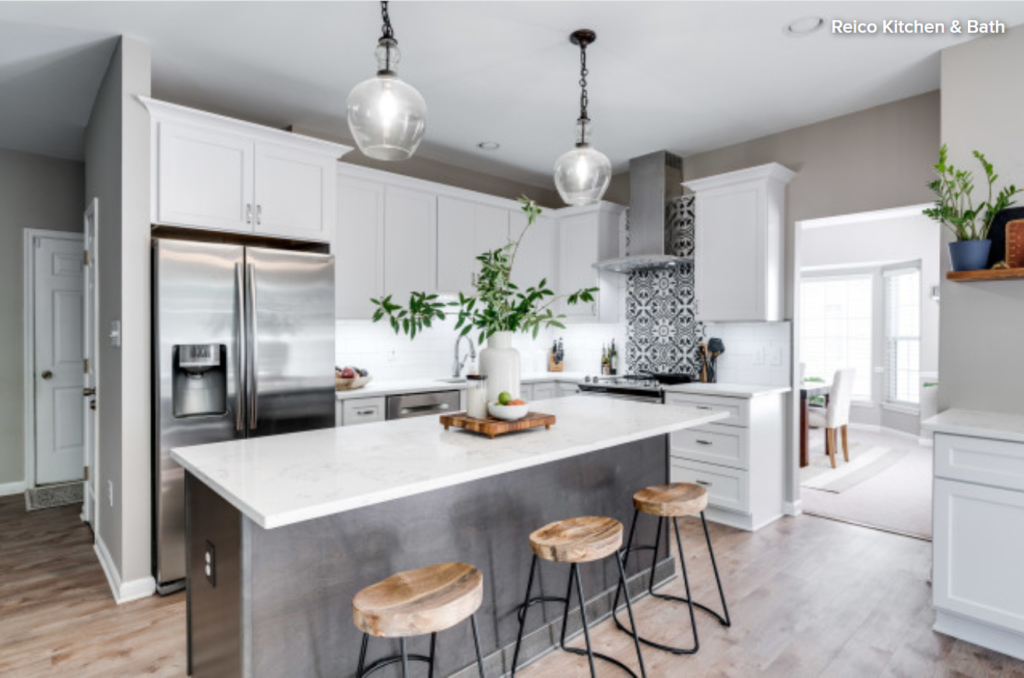
Smooth Solutions to Kitchen Counter Corners
The designers of these kitchens found creative ways to ease the transition from counter to walking zone.
Erin Carlyle April 26, 2020. Writing about the cost of renovation and what it takes to remodel. Former Forbes real estate reporter. Fascinated by cool homes, watching the bottom line.
It’s pretty standard for kitchen cabinets to run in a straight line until they meet the end of a wall or the start of a doorway. But sometimes, that isn’t the smoothest route. These six kitchens employ clever alternatives for ending a run of cabinets. Though the solutions vary, each makes the nearby passageway feel a little more smooth. Could this be a solution for your kitchen?
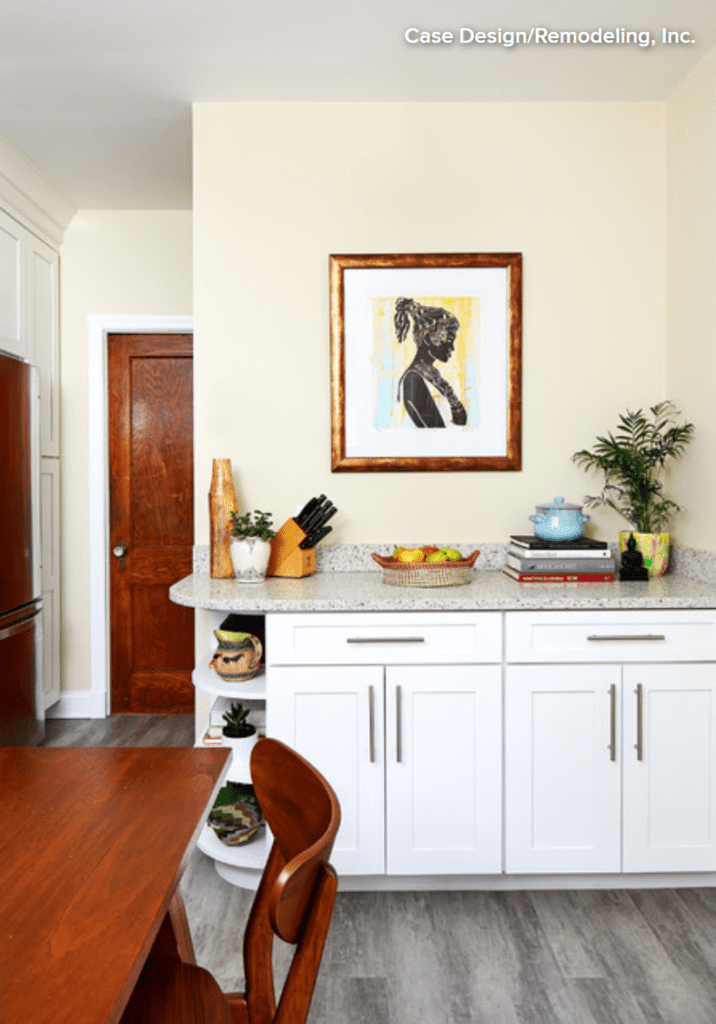
1. Curved Toward Walkway
For this Northwest Washington, D.C., kitchen by Case Architects & Remodelers, the designer gave the countertop a curve to soften the lines and give the space a transitional feel. The curve is also a practical choice because the counter abuts a walkway that heads toward a door. A curve in the pebbled quartz countertop means there’s no sharp corner to hit should you make a misstep.
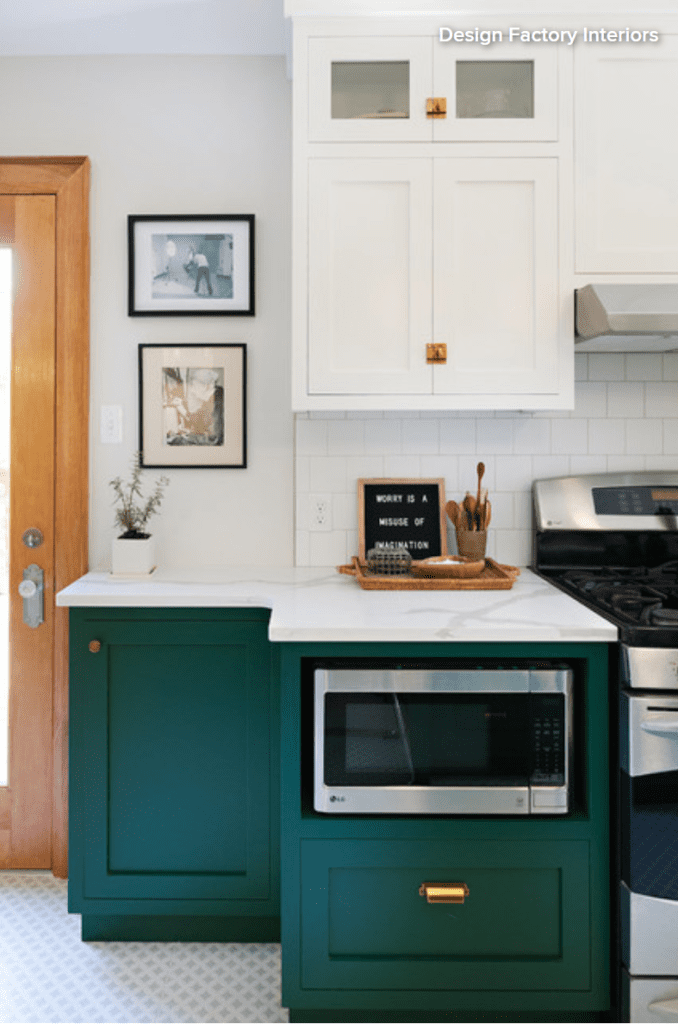
2. Recessed by Door
Another way to pull the counter back from the walkway is to recess it, as Shannon Eckel-Braun of Design Factory Interiors did for this Waterloo, Ontario, kitchen. Instead of a full-depth cabinet abutting the door that leads outside, a 12-inch-deep cabinet creates some breathing room. “I wanted it to be recessed back so you feel like you can smoothly walk around it,” Eckel-Braun says. “I didn’t want the countertops to just end.”
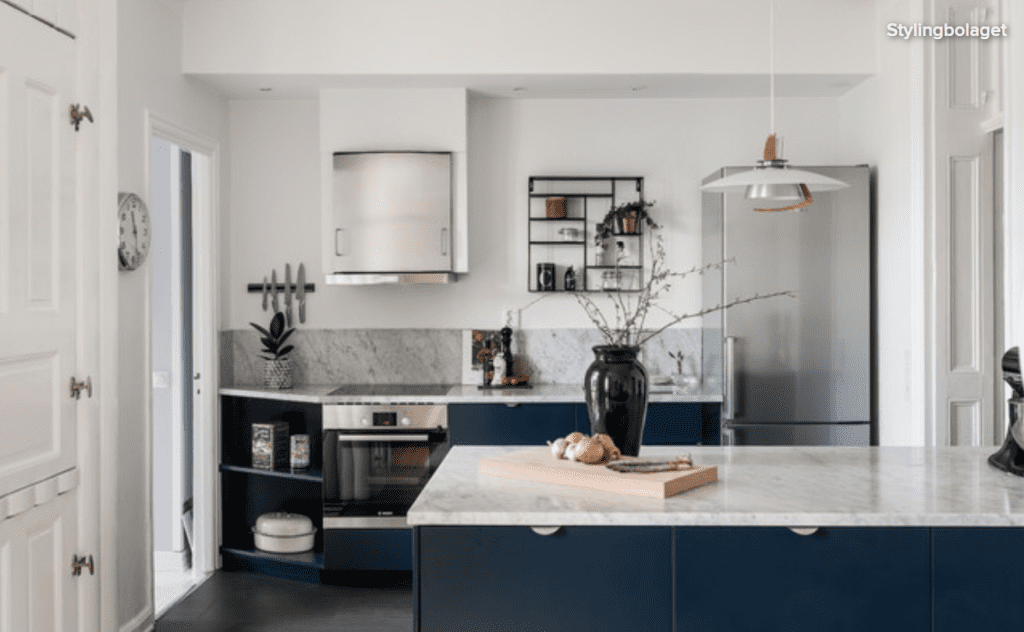
3. Angled by Door
This kitchen in Stockholm, Sweden, by Stylingbolaget has a range that sticks out farther than the doorway wall. One option would have been to stop the run of counter where the range ends.
But the designer found a solution that also adds storage: angling the countertop to the left of the range so it forms a wedge that looks interesting but not awkward. More important, it creates a smooth route in and out of the kitchen. And with the space used for open shelving rather than a traditional closed cabinet, all that space is easily accessed.
Here’s a more traditional way to angle a counter near a doorway: with a corner cabinet. The shape of this end run of cabinets in Oakland, California, by Kitchens by Francis invites you into the room. It also smooths the way out — you can glide right by via an efficient diagonal route.
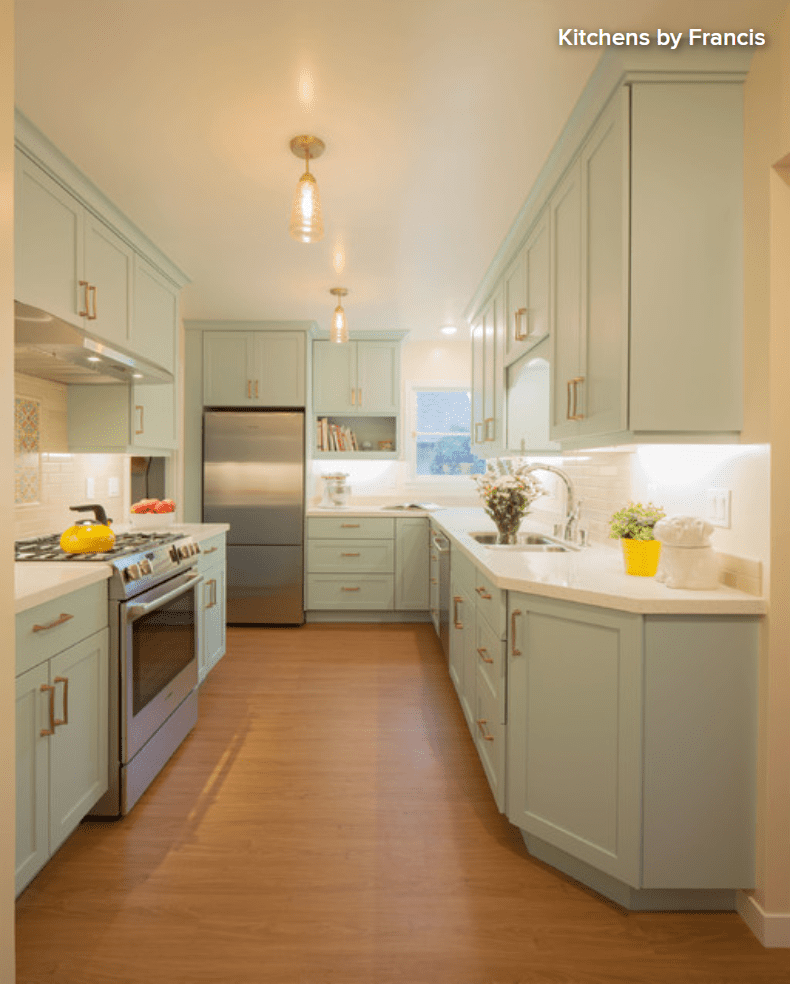
4. Rounded on End of Run
The designer of this kitchen in Hampshire, England, used curves to soften the lines of this long, narrow kitchen. The curve of the tall breakfast table echoes the curve of the cabinet by Lewis Alderson & Co. Both curves distract the eye from the otherwise long, straight shape of the space. The cabinet’s curve also allows space for a walkway around the table.
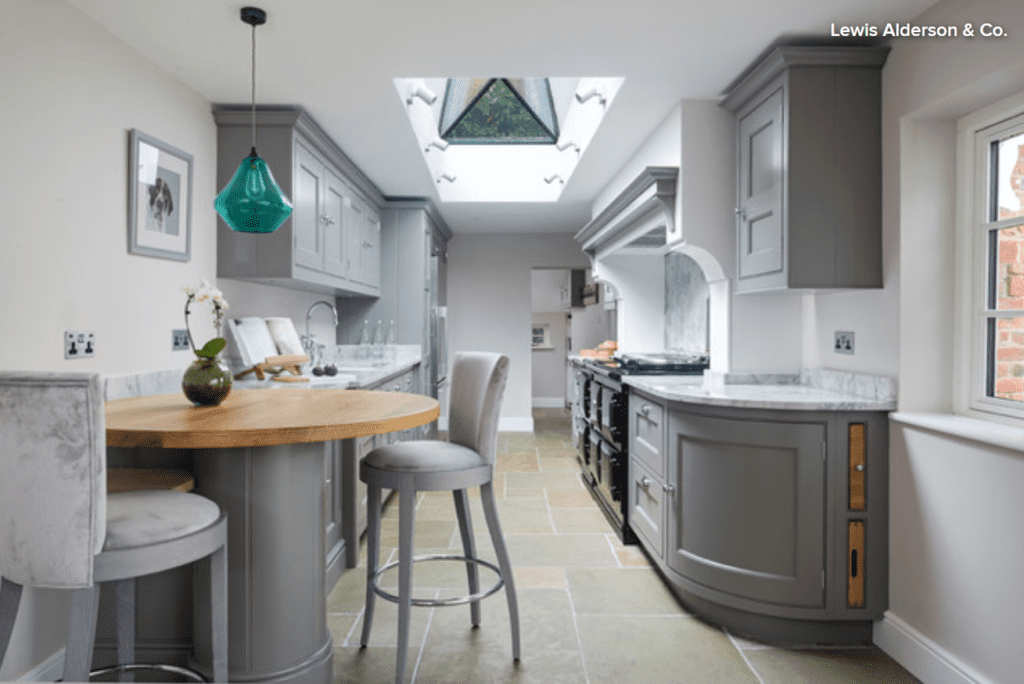
5. Rounded on Island
In this Minneapolis kitchen by Crystal Kitchen + Bath, squared-off cabinets at the perimeter maximize storage, but the curved shape of this island’s end zone offers a practical way to avoid uncomfortable bumps where people tend to hang out. As with the first example in this story, rounding the island adds to the room’s transitional feel, as do the speckled countertops and horizontal bar pulls on the cabinets.
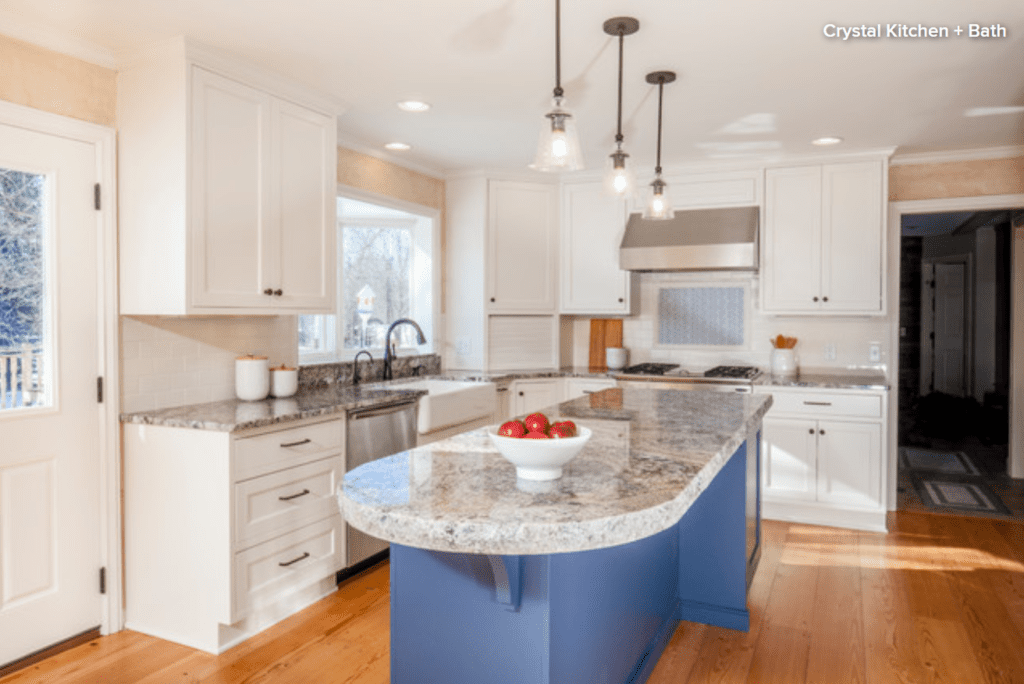
Cosentino showcase stunning design at KIPS Bay Decorator Show House in Palm Beach
Discover all the spaces designed using Dekton® and Silestone® by Cosentino.
Cosentino is honored to sponsor the third annual Kips Bay Decorator Show House Palm Beach, a stunning and creative showcase transforming a plantation-style home as told by leading interior designers across the country featuring best-in-class brands — all benefiting the Boys & Girls Clubs of Palm Beach County and the Kips Bay Boys & Girls Club. Dekton and Silestone by Cosentino are part of the stunning designs showcased in the space. www.cosentino.com Learn more about Cosentino and its brands:
Web: https://www.cosentino.com Facebook: https://www.facebook.com/GrupoCosentino/ Instagram: https://www.instagram.com/grupocosentino LinkedIn: https://www.linkedin.com/company/cose…
5 Trade-Offs to Consider When Remodeling Your Kitchen
It would be great to have an unlimited budget for a kitchen renovation. But the fact is most of us do not. And that’s OK. Compromises of one form or another are part of the process, even for the rare homeowner who enjoys a bottomless budget and expansive square footage.
But how, exactly, do you decide between two compelling options with different pros and cons? The most critical tool to have on hand to help you make tough choices is a clear picture of your remodel goals. To get clarity on what matters most to you, read about some key trade-offs you and your kitchen designer will consider during your project.
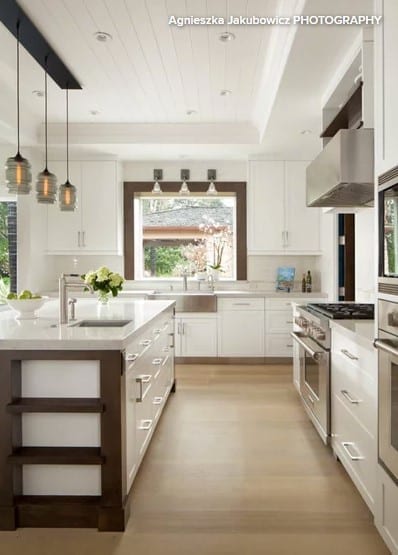
How Will You Use Your Kitchen?
When planning a kitchen remodel, you want to be very clear on how you want to use your new kitchen. Here is one example: I want to have people over more often. I want to feel relaxed when I entertain. In order to feel relaxed, I need to make sure that no one is in my way while I cook. I also want my kitchen to stay neat during the cooking process and be laid out so that cleaning up will be efficient.
Clear goals can help homeowners make decisions and, as the budget nears its limit, ultimately choose the options that will best support their goals. What matters most to you in a kitchen?
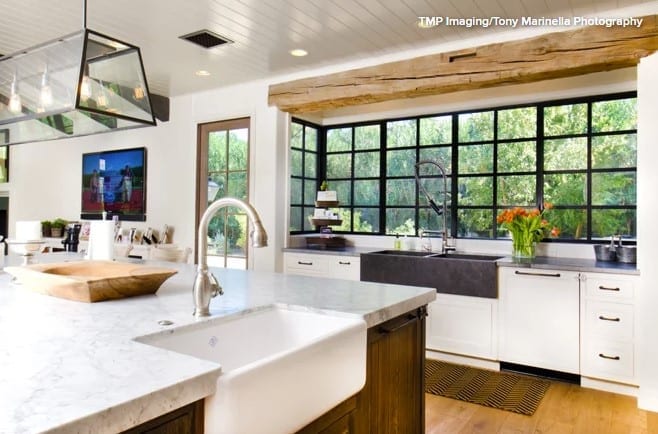
1. Daily Use vs. Special Events
This area of consideration has to do with how many people your kitchen will serve. From refrigerator storage to seats at the dining table, the number of people you want to accommodate will affect your design choices. You’ll want to consider not only how many people live in the home now, but — if this is your forever home — how many will live in it 10 years from now. Also, how often do you entertain and for how many people?
I had a client who was retired and cooked only for herself and her husband most days. She entertained just four times a year, on holidays. At first, I was a bit baffled by her choice of a 36-inch range, double ovens and a 48-inch-wide refrigerator. But for her, these choices made sense.
As the matriarch of a large family, on those four holidays she cooked for 25 to 30 people and had at least two or three people helping her in the kitchen. It was important to her that we designed a flexible space that worked just as well when cooking for two as for 30.
That approach is a good one: Whenever possible, I recommend that clients design with their maximum capacity needs in mind.
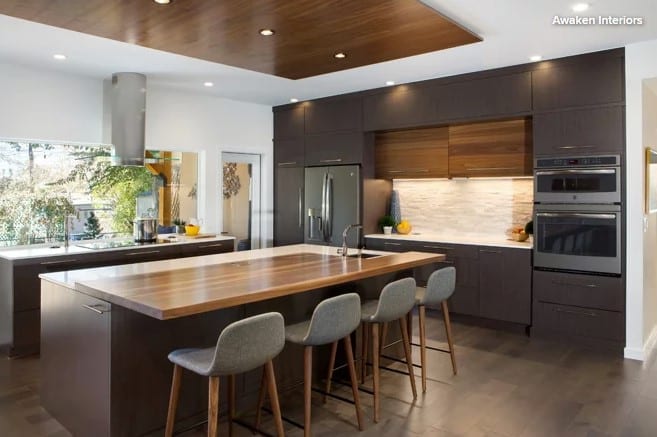
2. Cost vs. Value
As you may have discovered if you’re considering a remodel (or in the midst of one), everything from cabinets to sinks to appliances comes at a variety of price points. How do you decide when it’s worth it to splurge for a high-quality item and when it’s best to save your dollars? Here are some questions to ask yourself:
-
Will the investment improve your everyday life?
-
Will the product solve a pet peeve?
-
Will the addition of this element make your house feel like a home?
-
Will the purchase increase the value of your home?
In each of these cases, you may decide that the cost of a feature for your new kitchen is worth it because of the value it brings. For example, a better dishwasher might eliminate the need to prerinse dishes.
Perhaps you hate scrubbing dishes, can afford an upgrade and would cherish any minute of spare time away from the sink. Or perhaps you feel quite the opposite: You don’t mind scrubbing dishes at all, and this investment wouldn’t be worth the pennies spent.
Framing your choices as cost vs. value — in terms of your experience in your kitchen, and possibly the resale value of your home — can help you get clarity on what’s worth the extra money.
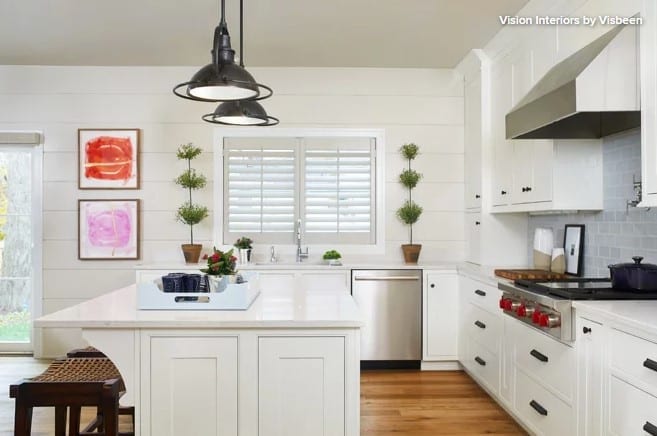
One helpful way to prioritize your desires is to analyze the frequency and duration of a given task. Tasks you do frequently or spend more time on should get more weight as you consider what is worth investing in.
For example, most people use the burners to cook 80 percent of the time, the oven 20 percent of the time. If this applies to you, I recommend prioritizing the cooktop as opposed to the wall oven, both in terms of placement in your kitchen and quality of product. You wouldn’t want to give up a great burner feature to get a fancier oven.
On the other hand, if you are a frequent baker but rarely use the stovetop, you may prefer to invest in wall ovens rather than spend your budget on a fancy range. For you, it would be better to make sure that reaching into the oven is more ergonomic — done while standing upright, rather than bending over.
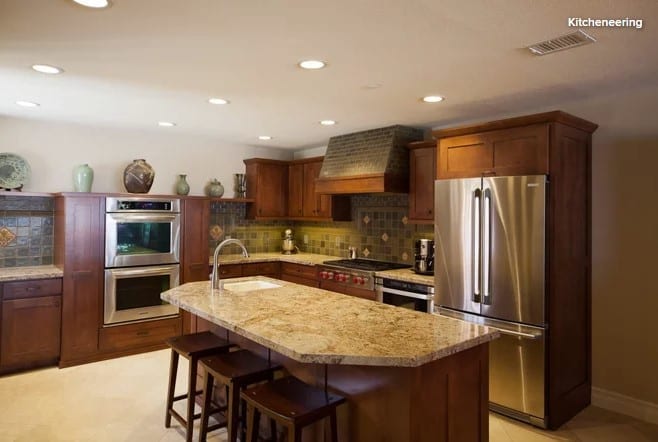
3. Function vs. Aesthetics
Ideally a kitchen redesign brings both beauty and function, but when we are dealing with limited funds, trade-offs between functionality and aesthetics may be necessary. By function, I mean not only the kinds of bells and whistles you get with high-end appliances, but also the kitchen’s layout and the choice of whether to have one sink or two.
Aesthetics, of course, are the expensive but gorgeous finishes and customized detailing that bring a high-end look to a kitchen. Quite often, a budget may force you to make choices on what matters most to you — the functionality or the look.
This area of trade-off is deeply personal and has a lot to do with your lifestyle. When weighing aesthetics vs. function, you’ll want to consider everything I mentioned before: how many people you cook for daily, how often you entertain, the kind of entertaining you do (backyard barbecues vs. sit-down dinners), the style of cooking you prefer and how many people work in the kitchen at one time.
For example, a client who doesn’t do a lot of cooking and is more concerned with the kitchen’s look than its function might really want a beautiful built-in fridge with custom panels but be willing to use a less expensive range or counter material to have that pricey, beautiful fridge.
On the other hand, I have had several clients (including the owners of the kitchen in this photo) who chose a free-standing fridge and put their budget into the plumbing and construction work required to add a second sink. To me, this is a significant functional improvement and, for those who enjoy cooking and entertaining, worth scaling back on some of the aesthetic details.
There are many ways you can cut back on aesthetics to create room in your budget for what’s important to you functionally. You might consider a simpler, less expensive door style on the cabinets, or a ceramic backsplash tile instead of glass, or quartz counters instead of granite.
I even had one client use a very inexpensive laminate counter so that she could put more money into the remodel work necessary to get the layout just right. Since she was in her forever home, she replaced the laminate with a beautiful stone two years later when finances allowed.
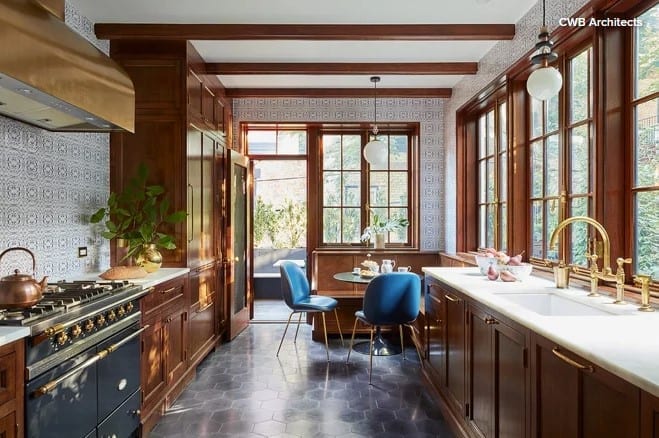
4. Speed vs. Patience
Any home improvement project takes time — that’s just part of the process. And once the kitchen is demolished and construction is underway, any delay can be difficult, particularly if you are living in the home and dealing with the mess. When you are in that situation, the risk is that you will be tempted to say yes to anything just to get the project done and your home back to normal.
This happened with one of my clients, who decided to use a second-choice backsplash because it was in stock, whereas her first choice had a month lead time. On the other hand, a different client had trouble finding a backsplash tile she liked, so she finished her kitchen and skipped the backsplash altogether. Three months later, she found the perfect tile and brought the tile installer back. I am sure you can guess which homeowner was more happy with her kitchen remodel.
When making a large financial investment that you are going to live with a long time, I recommend that you go slowly, taking the time to find the right people to help and weighing your decisions carefully.
That being said, speed can be a necessary evil. Perhaps you are remodeling for a special event, such as a backyard wedding. Or maybe you are planning to sell the house and just want a quick face-lift to get the most out of your investment.
As a guide when weighing the need for speed vs. the need to exercise your patience muscles, I recommend you consider how long you plan to live in your home. If you’re going to sell within five years, keep in mind that everything doesn’t have to be perfect — you simply want to be sure you will get your investment back when you sell. However, if you plan to live in the home for 10 years or more, it’s worth slowing down and investing in your quality of life. Take the time to find the right solution, not the quick one.
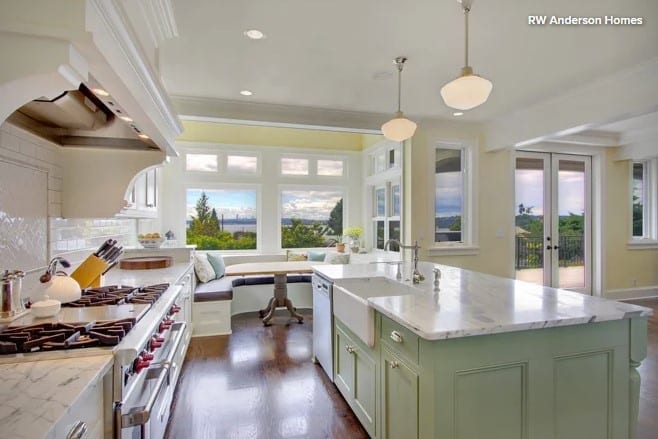
5. The Ideal Me vs. the Real Me
This one isn’t so much a trade-off as a reality check. It’s worth mentioning that some clients have fantasies that a remodel can change their habits — or even their personalities. But my observation has been that if you are already a messy cook, the chances of a new kitchen transforming you into a clean-as-you-go type are pretty slim.
Rather than plan a kitchen for the person you wish you were, focus on solutions that take your true habits into account. For example, a messy cook who is embarrassed when guests are around might want to add a separate cleanup sink where he can hide dirty dishes while making a meal.
Or, if clutter is a constant problem, a homeowner might want to create a hidden drop zone for papers, cellphones, pens and other detritus that kitchen counters tend to attract.
5 Favorite Granites for Gorgeous Kitchen Countertops
Article by: Charmean Neithart
Selecting a countertop material for your kitchen remodel or new build is a big decision. I often encounter clients with a mental block when it comes to making a decision on the numerous considerations, like color and edge detail. Additionally, once the countertop hurdle is over, then there is cabinet selection.
I like granite and use it often for its durability and its earthy colors that add great texture to a kitchen. I have a few favorites that I have worked with over the years. These granite selections get my stamp of approval because of color, movement and their flexibility in complementing different cabinet styles. Take a look at these countertop selections and how they seamlessly blend with either painted or stain-grade cabinets to make winning combinations.
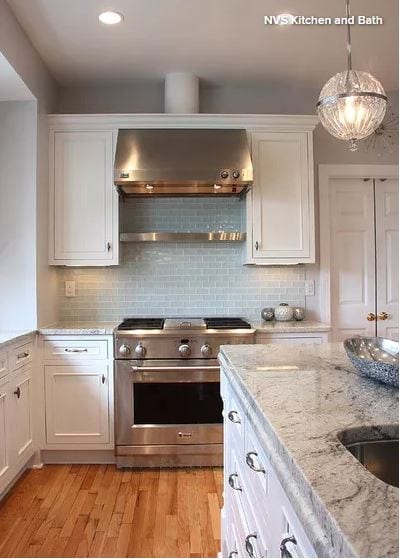
1. Bianco Romano
Bianco Romano with painted cabinets. I suggest this granite when I have a homeowner who wants that classic white kitchen. This granite works great with pure white, warm white or beige cabinets. Additionally, nickel or oil-rubbed-bronze hardwareworks great with all the colors of the stone, which include white, cream, gray and a deep bordeaux.
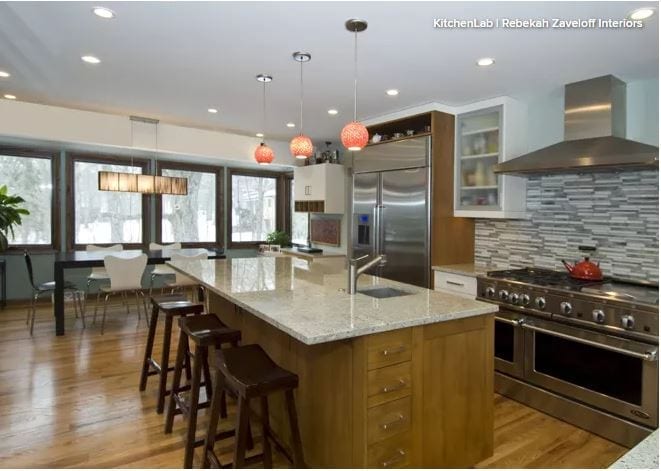
Bianco Romano with stain-grade cabinets. Due to the warm white, beige and gray palette, this granite works equally as well with stain-grade cabinets. I have seen it work beautifully with walnut and medium oak.
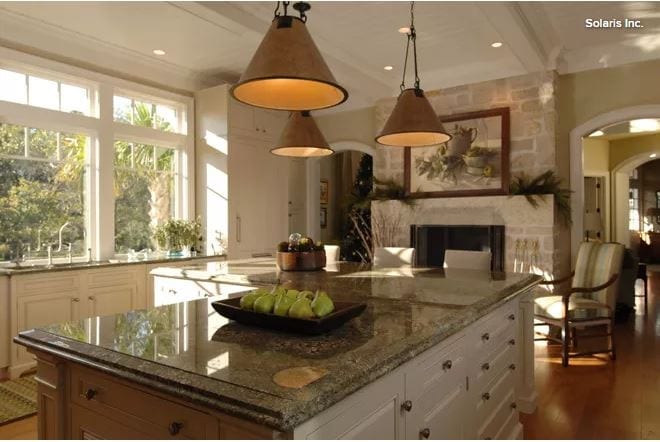
2. Seafoam Green
Seafoam green with painted cabinets. This granite is just beautiful. The shade of green is earthy, with gray and brown undertones. There are great markings in the stone that look almost geometric to me. This granite works with painted cabinets and satin nickel hardware. I prefer this stone when it is polished.
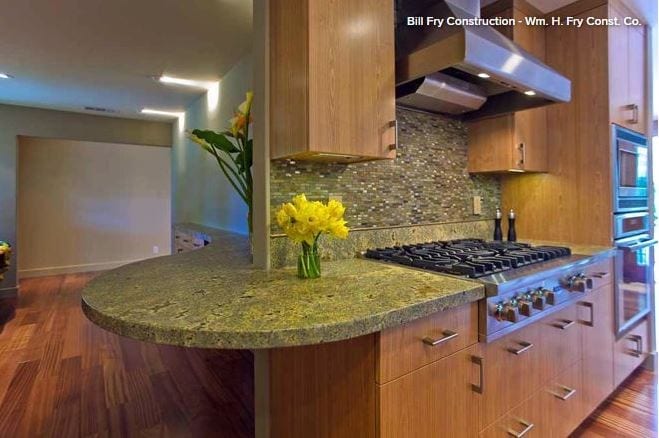
Seafoam green with stain-grade cabinets. If you are looking for a rustic or earthy feel for your home, this is a great combination. Add oil-rubbed-bronze or copper fixtures for the perfect lodge experience.
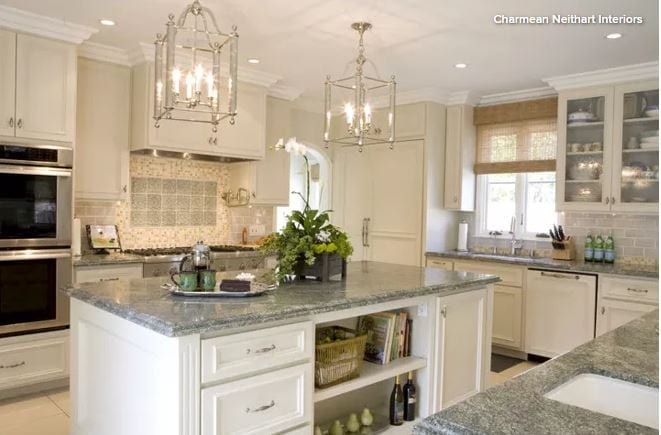
3. Costa Esmeralda
Costa Esmeralda with painted cabinets. I first came across this granite when I had a homeowner ask me to create an ocean palette throughout the house. This granite is between green and blue, and of course will vary from batch to batch. The green-blue of the stone blends perfectly with sandy white cabinets and nickel hardware and fixtures.
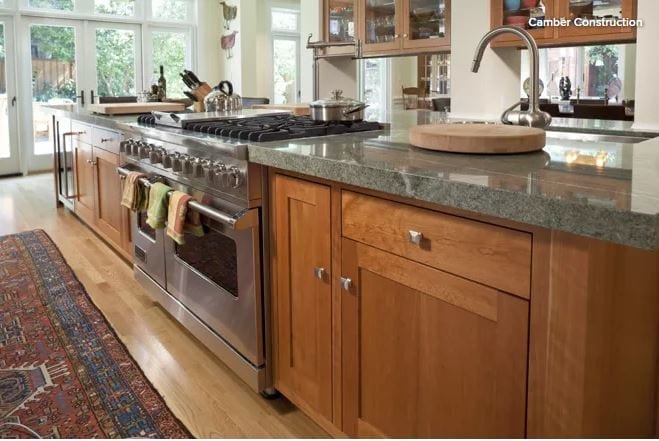
Costa Esmeralda with stain-grade cabinets. It’s equally stunning with stain-grade cabinets, for a masculine and warm look. This granite works particularly well in light-filled kitchens; the sunlight highlights the stone’s complex coloring.
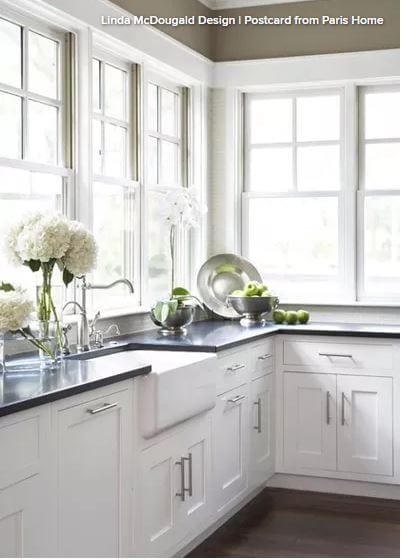
4. Absolute Black
Absolute Black with painted cabinets. This is my idea of a classic kitchen. I love this traditional look of white cabinets and Absolute Black granite, which looks great polished or honed. Painted cabinets in many colors pair perfectly with this granite, and nickel, chrome or oil-rubbed-bronze fixtures and hardware look terrific.
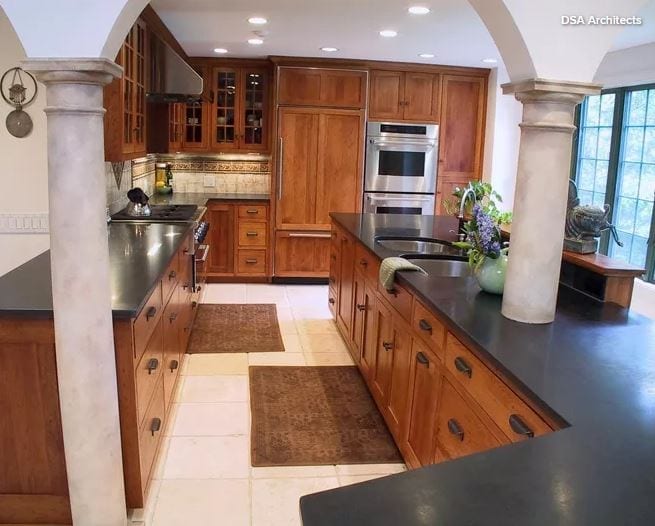
Absolute Black with stain-grade cabinets. Another classic look that can feel rustic or modern. I love Absolute Black with medium oak or walnut. Rift-cut oak also has a great transitional look.
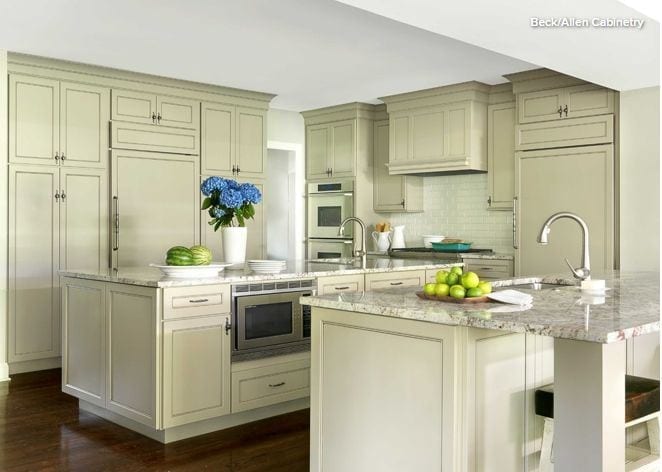
5. Typhoon Bordeaux
Typhoon Bordeaux with painted cabinets. One of my favorite granite selections, Typhoon Bordeaux comes in cream, gray, brown or brick red. It’s a perfect choice for a light kitchen that has red undertones in the flooring. This granite really can vary by batch, from subtle brick-red veining to strong waves of brick red. Try it with beige or cream cabinets for a warm, light-filled kitchen.
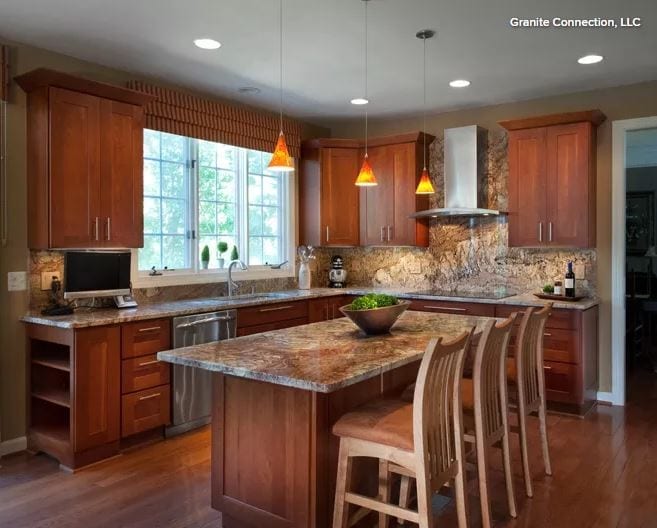
Typhoon Bordeaux with stain-grade cabinets. I’m a sucker for warmth, so this combination really appeals to me. The brick red and browns in this granite pair beautifully with walnut, oak, mahogany and cherry cabinets. It works well in Spanish homes that feature Saltillo floors. The deep red and brown in the granite and the rustic charm of Spanish architecture are a match made in heaven.
Smart Investments in Kitchen Cabinetry — a Realtor’s Advice
The kitchen is the most expensive room in the house to build. The national average cost of a kitchen remodel is $50,000, though the real cost can vary widely, depending on where you live, the scope of the project and the materials you choose. New cabinetry can take up much of that expense. Make the most of this big purchase by treating your new cabinets as an investment.
Realtor Victoria Gangi offers insider tips on how to get the best return on your cabinet investment, even if you’re not moving in the foreseeable future.
Silestone Expands Eternal Collection Designs
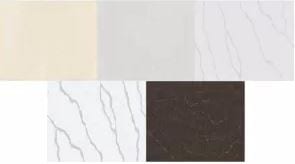
Silestone has expanded its luminary collection with the introduction of five new colors. The new hues offer a modern, reinvented take on some of the most sought-after marbles and stones, coupled with the latest technological advancements from Silestone. The Eternal Collection is the first in Silestone’s offering to have veining and highlights run completely through the material, including its edges, resulting in an even more natural appearance. The five new colors, which bring the collection to a total of 10 colorways, include Eternal Bianco Calacatta, Eternal Classic Calacatta, Eternal Desert Silver, Eternal Emperador and Eternal Marfil.
The beauty of the material is met with industry-leading performance, thanks to its Silestone N-Boost technology. This innovation patented by Cosentino modifies the material’s surface at a molecular level to further enhance its outstanding technical and aesthetic attributes: Greater color saturation and extraordinary luster, along with an enhanced water repellent property that reportedly makes it even easier to clean and maintain. As with all Silestone natural quartz products, the Eternal Collection includes high resistance to impact and scratching; is manufactured in large formats; and offers versatility of application.
Eternal Bianco Calacatta: The luminary hue of the 2018 collection combines thick, electric veins with a soft gray background for drama and contrast, creating an instant focal point in any space. Eternal Calacatta Classic: Elegant and subtle, Eternal Calacatta Classic reinterprets coveted Calacatta marble. Its uniform grayish veins stretch across the slab with a translucent appearance, evoking an authentic resemblance to real stone.
Eternal Desert Silver: More monochromatic in its appearance, Eternal Desert Silver offers an icy, translucent aesthetic creased by fine, clear veins. Inspired by the classic and long-lasting marble trend, it complements any type of material and architectural element.
Eternal Emperador: A warm, tobacco brown background set against light and streaks embraces earthy tones reflective of a growing demand for moody, darker marbles.
Eternal Marfil: Creamy, soft and minimalist, Eternal Marfil puts a unique spin on Crema Marfil marble to bring an organic serene aesthetic to the space.
Match Made in Heaven
Matching your backsplash to your kitchen countertop is truly an art form. Come talk to the best designers in the industry at American Cabinet & Flooring, Inc. because seeing is believing!
